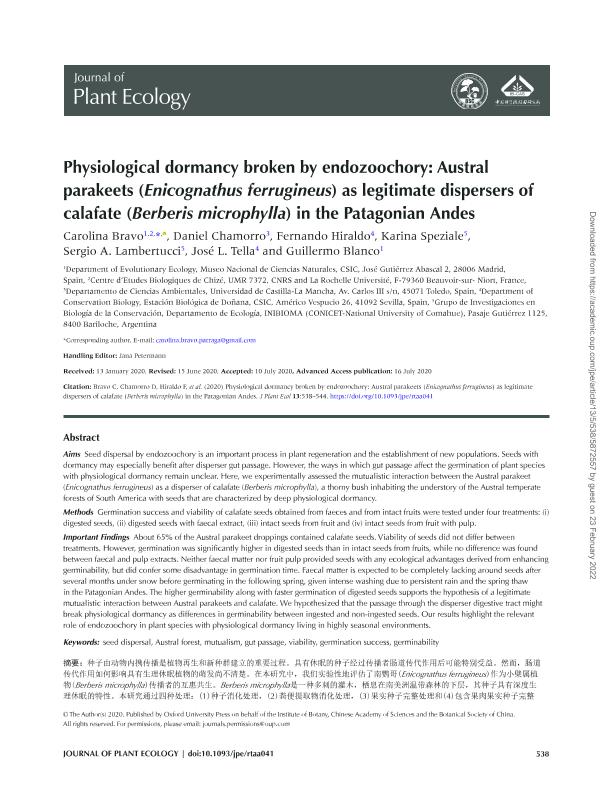Artículo
Aims: Seed dispersal by endozoochory is an important process in plant regeneration and the establishment of new populations. Seeds with dormancy may especially benefit after disperser gut passage. However, the ways in which gut passage affect the germination of plant species with physiological dormancy remain unclear. Here, we experimentally assessed the mutualistic interaction between the Austral parakeet (Enicognathus ferrugineus) as a disperser of calafate (Berberis microphylla), a thorny bush inhabiting the understory of the Austral temperate forests of South America with seeds that are characterized by deep physiological dormancy. Methods: Germination success and viability of calafate seeds obtained from faeces and from intact fruits were tested under four treatments: (i) digested seeds, (ii) digested seeds with faecal extract, (iii) intact seeds from fruit and (iv) intact seeds from fruit with pulp. Important Findings: About 65% of the Austral parakeet droppings contained calafate seeds. Viability of seeds did not differ between treatments. However, germination was significantly higher in digested seeds than in intact seeds from fruits, while no difference was found between faecal and pulp extracts. Neither faecal matter nor fruit pulp provided seeds with any ecological advantages derived from enhancing germinability, but did confer some disadvantage in germination time. Faecal matter is expected to be completely lacking around seeds after several months under snow before germinating in the following spring, given intense washing due to persistent rain and the spring thaw in the Patagonian Andes. The higher germinability along with faster germination of digested seeds supports the hypothesis of a legitimate mutualistic interaction between Austral parakeets and calafate. We hypothesized that the passage through the disperser digestive tract might break physiological dormancy as differences in germinability between ingested and non-ingested seeds. Our results highlight the relevant role of endozoochory in plant species with physiological dormancy living in highly seasonal environments. 种子由动物内携传播是植物再生和新种群建立的重要过程。具有休眠的种子经过传播者肠道传代作用后可能特别受益。然而,肠道 传代作用如何影响具有生理休眠植物的萌发尚不清楚。在本研究中,我们实验性地评估了南鹦哥(Enicognathus ferrugineus)作为小檗属植 物(Berberis microphylla)传播者的互惠共生。Berberis microphylla是一种多刺的灌木,栖息在南美洲温带森林的下层,其种子具有深度生 理休眠的特性。本研究通过四种处理:(1)种子消化处理,(2)粪便提取物消化处理,(3)果实种子完整处理和(4)包含果肉果实种子完整 处理,测定了从粪便和完整果实中提取的B. microphylla种子的发芽成功率和活力。研究结果表明,大约65%的南鹦哥的粪便中含有B. microphylla种子。不同处理的种子存活率无显著差异。然而,消化后的种子萌发率显著高于完整果实种子,而粪便和果肉提取物处理之间没有差异。粪便和果肉都没有为种子提供任何提高发芽能力的生态优势,但在萌发时间上确实造成了一些劣势。由于持续降雨和巴塔哥尼亚安第斯山脉春季融雪带来的严重冲刷,种子附近的粪便在雪下几个月后就会完全缺失。消化种子较高的发芽能力和较快的发芽速度验证了南鹦哥和B. microphylla之间具有合理互惠共生的假设。因为消化和非消化种子发芽能力的差异,我们假设通过传播者的肠道传代作用可能打破种子的生理休眠。我们的研究结果强调了在具有高度季节性的环境下,具有生理休眠的植物物种中与动物内携传播的相关作用。
Physiological dormancy broken by endozoochory: Austral parakeets (Enicognathus ferrugineus) as legitimate dispersers of calafate (Berberis microphylla) in the Patagonian Andes
Bravo, Carolina; Chamorro, Daniel; Hiraldo, Fernando; Speziale, Karina Lilian ; Lambertucci, Sergio Agustin
; Lambertucci, Sergio Agustin ; Tella, José L.; Blanco, Guillermo
; Tella, José L.; Blanco, Guillermo
 ; Lambertucci, Sergio Agustin
; Lambertucci, Sergio Agustin ; Tella, José L.; Blanco, Guillermo
; Tella, José L.; Blanco, Guillermo
Fecha de publicación:
07/2020
Editorial:
Oxford University Press
Revista:
Journal of Plant Ecology-uk
ISSN:
1752-9921
e-ISSN:
1752-993X
Idioma:
Inglés
Tipo de recurso:
Artículo publicado
Clasificación temática:
Resumen
Archivos asociados
Licencia
Identificadores
Colecciones
Articulos(INIBIOMA)
Articulos de INST. DE INVEST.EN BIODIVERSIDAD Y MEDIOAMBIENTE
Articulos de INST. DE INVEST.EN BIODIVERSIDAD Y MEDIOAMBIENTE
Citación
Bravo, Carolina; Chamorro, Daniel; Hiraldo, Fernando; Speziale, Karina Lilian; Lambertucci, Sergio Agustin; et al.; Physiological dormancy broken by endozoochory: Austral parakeets (Enicognathus ferrugineus) as legitimate dispersers of calafate (Berberis microphylla) in the Patagonian Andes; Oxford University Press; Journal of Plant Ecology-uk; 13; 5; 7-2020; 538-544
Compartir
Altmétricas



